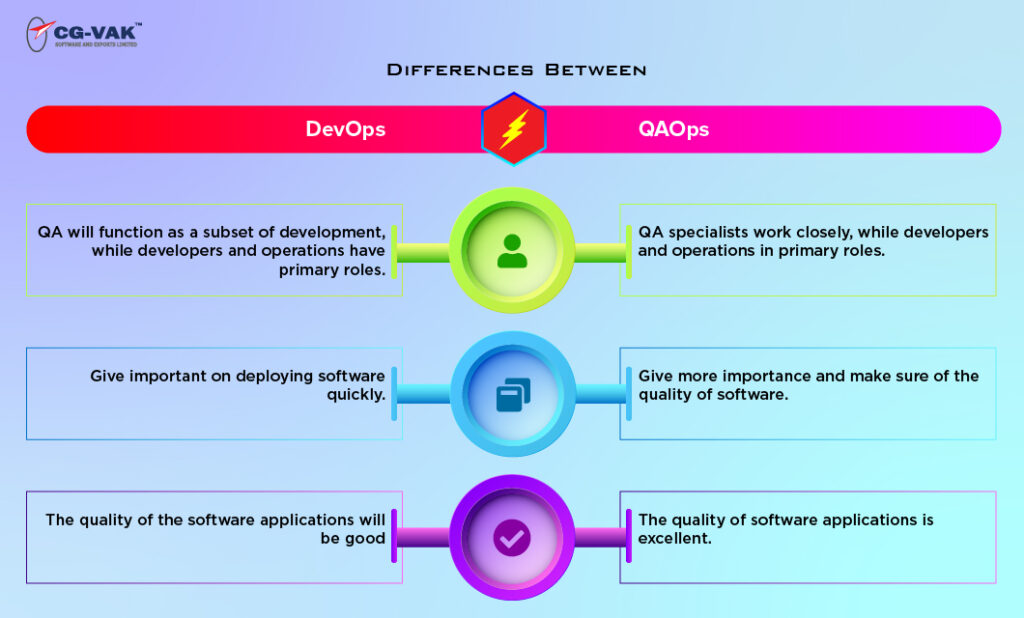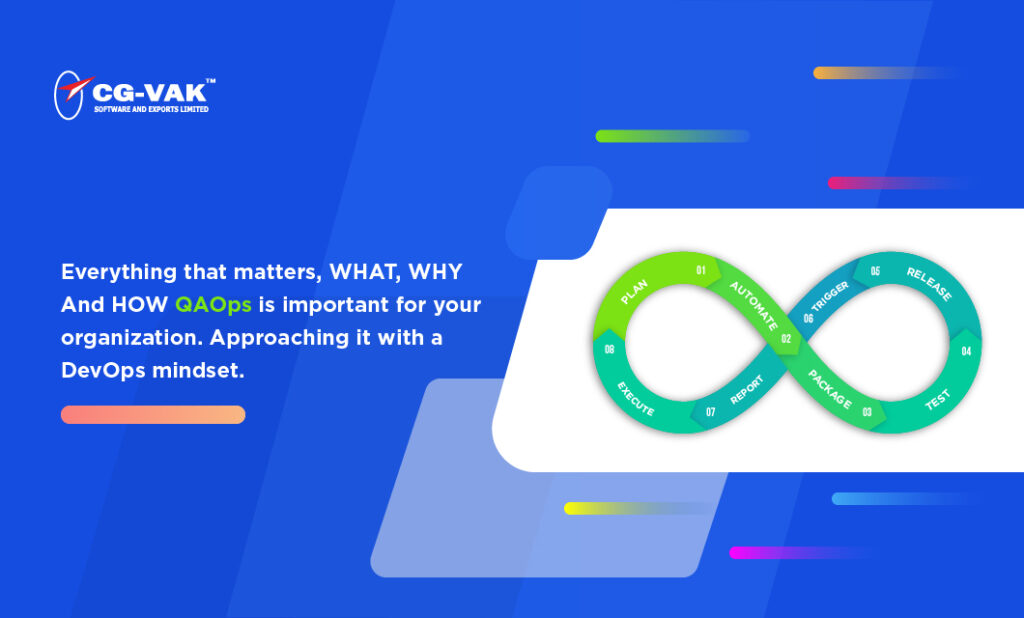In this modern technological world where all organizations are moving with the trends of automation with continuous delivery, whereby the product provides the best user experience to the customer, we focus and give priority to quality.
Maintaining a record of Ontime delivery with good quality At CGVAK has emerged through practicing QAOps.
With the DevOps approach making the software development process simpler and more effective,this article willlet us look into the effectiveness of QAOps and how it made its way to the industry.
To understand more, let us know what is QAOps?
The role of every individual involved in this process during the software development process has changed. Under testing, the role of QA or software tester is now not limited and is involved in every aspect of software development. QAOps is the practice that brings developers, testers, and operation teams together and continuous testing is combined with DevOps such as CI and CD, which bring the independent teams together.
CI and CD pipeline (Continues Integration and Continues Delivery) is the cornerstone of DevOps strategy. Continuous testing is done through the use of automation which makes the development cycle faster. With QAOps, the process is speeding up and gives more efficient results. When an application is created and with the release of the first version, you’ll see how it works. With CI and CD, you will find that there are a few or a lot of things you can do better. Thereby it increases the user’s satisfaction.
Why using QAOps?
By implementation of QAOps in DevOps there are some benefits which are as follows:
- The methodology of workflow that brings faster results with better quality.
- The QA team works with other team, thereby increasing their skill level.
- A higher degree of quality, stability, and reliability which ensures better customer experience.
Although less popular than DevOps, QAOps is fast emerging as a crucial methodology to pursue in the delivery lifecycle. In fact, in QAOps, the QA team holds a pride of place very similar to what a development team holds in the SDLC process.
It is important for an organization to know, how QAOps can be practiced?
There is no need for a complete cultural change in the workplace in the implementation of the QAOps setup. However faster results are acquired with the help of collaboration with developers and testers and the team. The application can be checked for any changes thoroughly before the release.
Therefore, the importance of communication is key to the technical team. Before implementing QAOps, they must understand the value behind this framework. By practicing this, the rest of the expertise like IT operation managers, developers, testing engineers, etc; have to understand the requirement and collaborate accordingly. It will take time to realize the importance of this framework which will take time to practice, but once the importance is served by having the QAOps framework the organization will be considered on a different standpoint of execution.
An organization needs three unique QAOPs process to practice:
- The tests should be triggered only based on the changes that are made to the functionality. The more the number of tests, the greater the time to run the tests and share the results. Therefore, the triggering step should be well planned and mapped with the automation testing life cycle
- Different tests will be executed on the functionality. To achieve parallel testing, make sure you have the infrastructure that can scale and distribute the loads according to the need. Which will execute the process as planned without any hiccups during the QAOps life cycle.
- Once the tests are triggered and executed, the reporting module showcases the results of the tests. A perfect reporting module design should provide quick summary information as well as provide detailed information. This will be helpful for anyone taking a look at the reports and compare the results.
These three unique steps ensure the stable release of the application, which will be validated and can be used within for organization development.
DevOps Explained!
DevOps uses CI/CI principles, which helps in rapid software testing and release. The testing team will verify the build at different stages of development and deploy them after verifying its run. It will continue in 2021 with more and more organizations adopting this patternwhich emphasizing communication, integration, and collaborationto manage end to end processes.
Differences between DevOps and QAOps?
There are a few differences between the two. Though QAOps is derivative of DevOps, the differentiation will give an understanding:

In a DevOps testing strategy, the DevOps specialists mainly comprise developers, testers in a secondary role, and members of the operations team. Thus, even though the main thrust is on quality, the QA specialists remain in the background. However, in QAOps, the operations team mainly communicates and collaborates with the QA team to ensure continuous delivery with excellent quality.
Best practice of QAOps Be Referred As Continuous Testing in DevOps
By the continuous testing process into SDLC, CG-vak achieves a successful delivery cycle. With previous experience here is some best practice to follow continuous testing as a part of the DevOps process:
- By reducing risk and ensure faster release and time to market.
- All the teams in the organization ensure to collaborate and communicate efficiently during the entire course of the release.
- Doing CI/CD on regular basis, and each person’s works should be merged into the release pipeline which will help to identify the defects at the early stage.
- During development, it will be more effective if the quality teams work alongside the development team to provide vital inputs.
- During the release process in the defined interval, every team’s metric should be measured.
- QA test engineers should make use of automation tools and scripts to automate as much of the testing as possible. Deep regression testing will make sure existing features are not broken.
- Developers and testers should start thinking about each point of view, which will make everyone responsible for the overall quality.
Conclusion
Although it is quite new, QAOps is an emerging trend that allows the automation of processes between software development, IT, and QA. when correctly designed and implemented, definitely paves the road to faster software delivery, bringing QAOps into action involves a great deal of persuasion on the part of the business stakeholders. Once you’ve passed this point, it’s supposed to be a smooth sail ahead.
